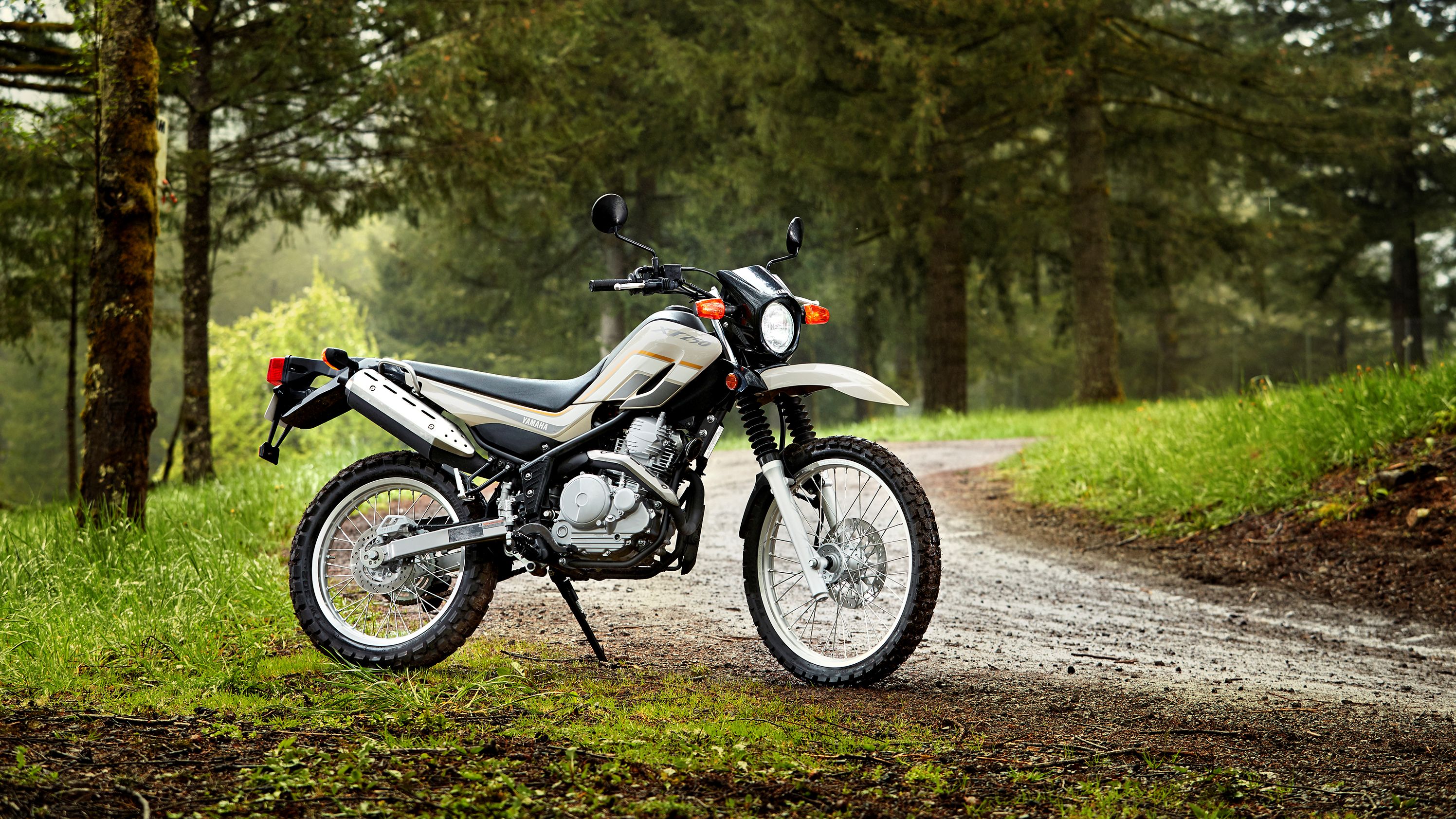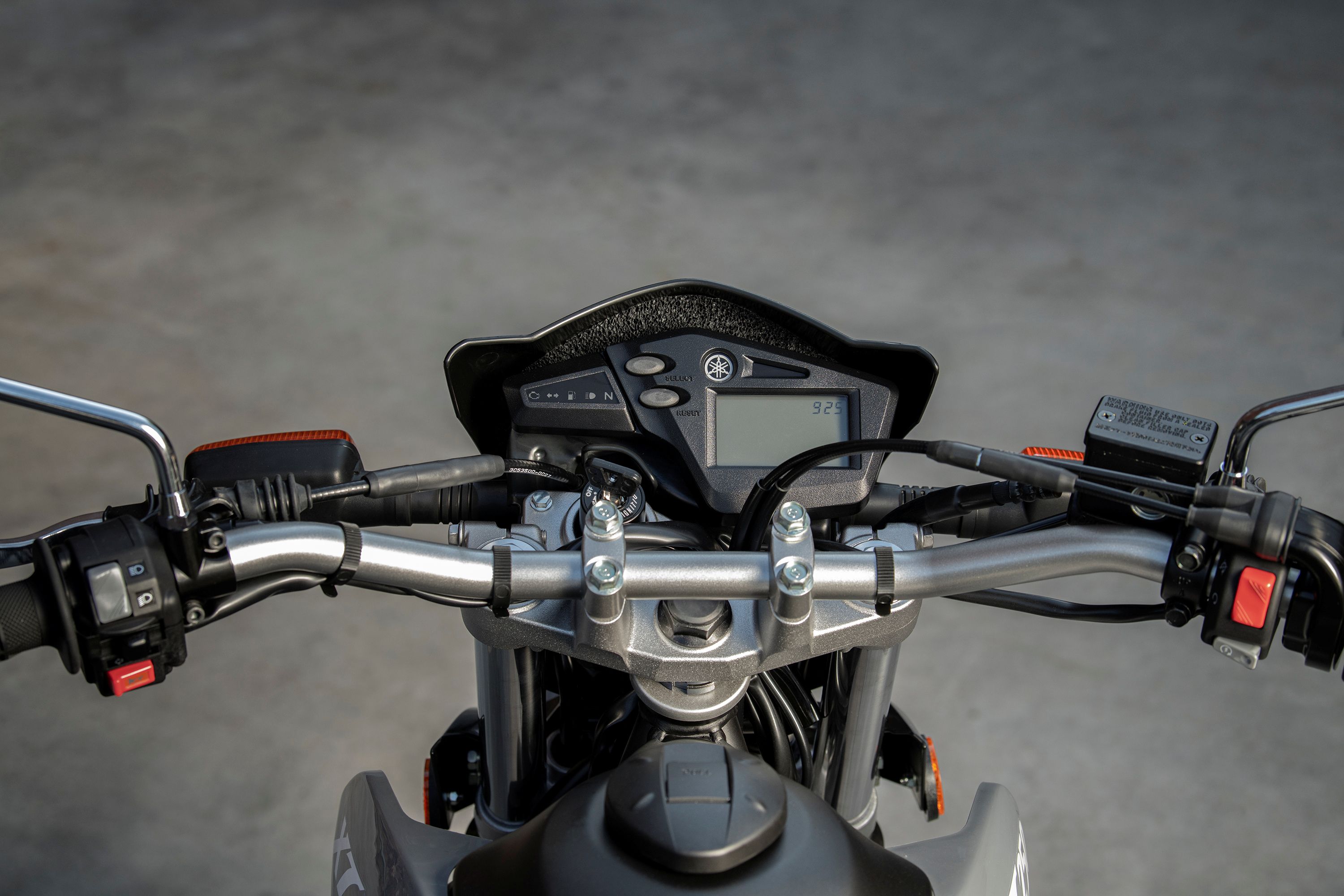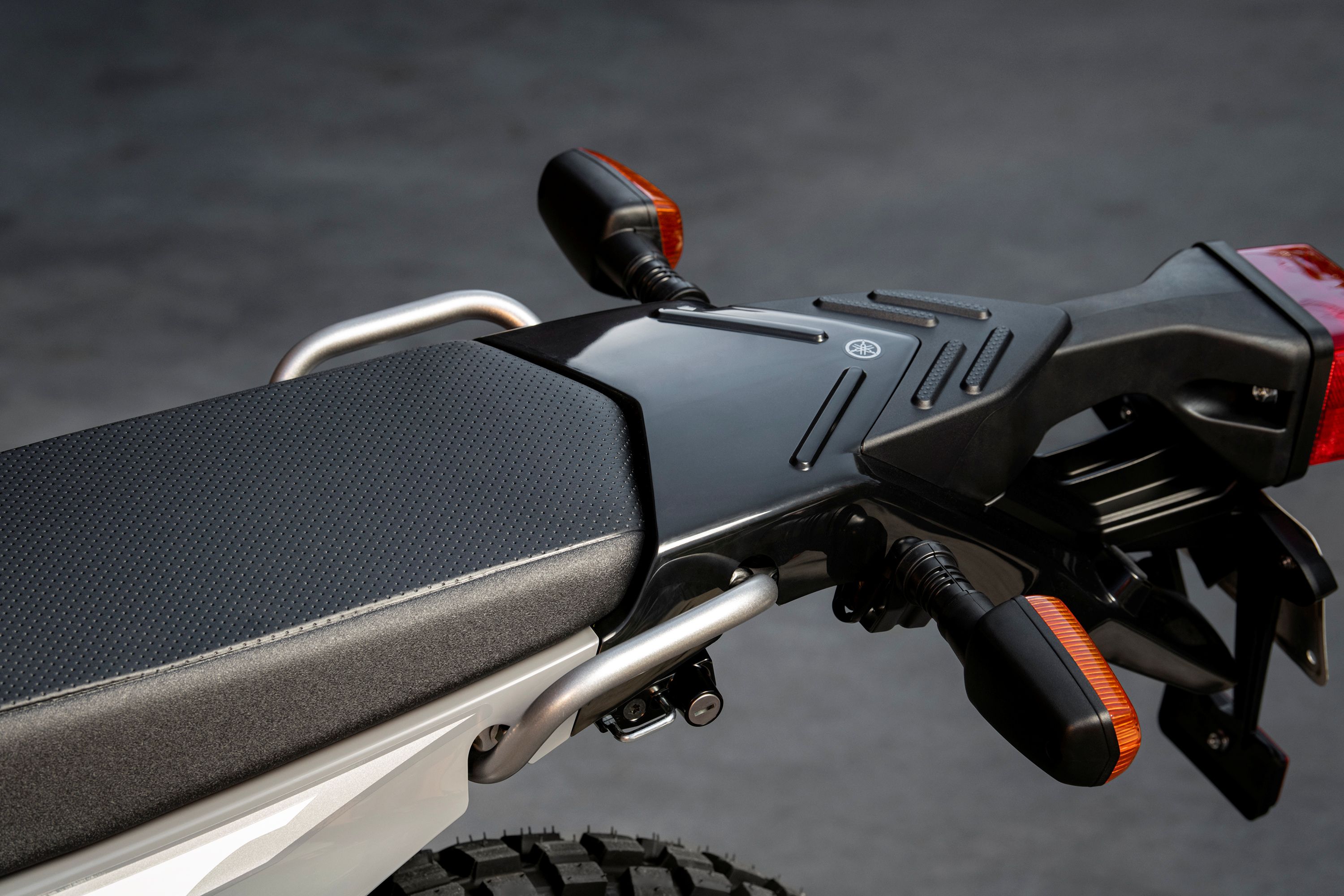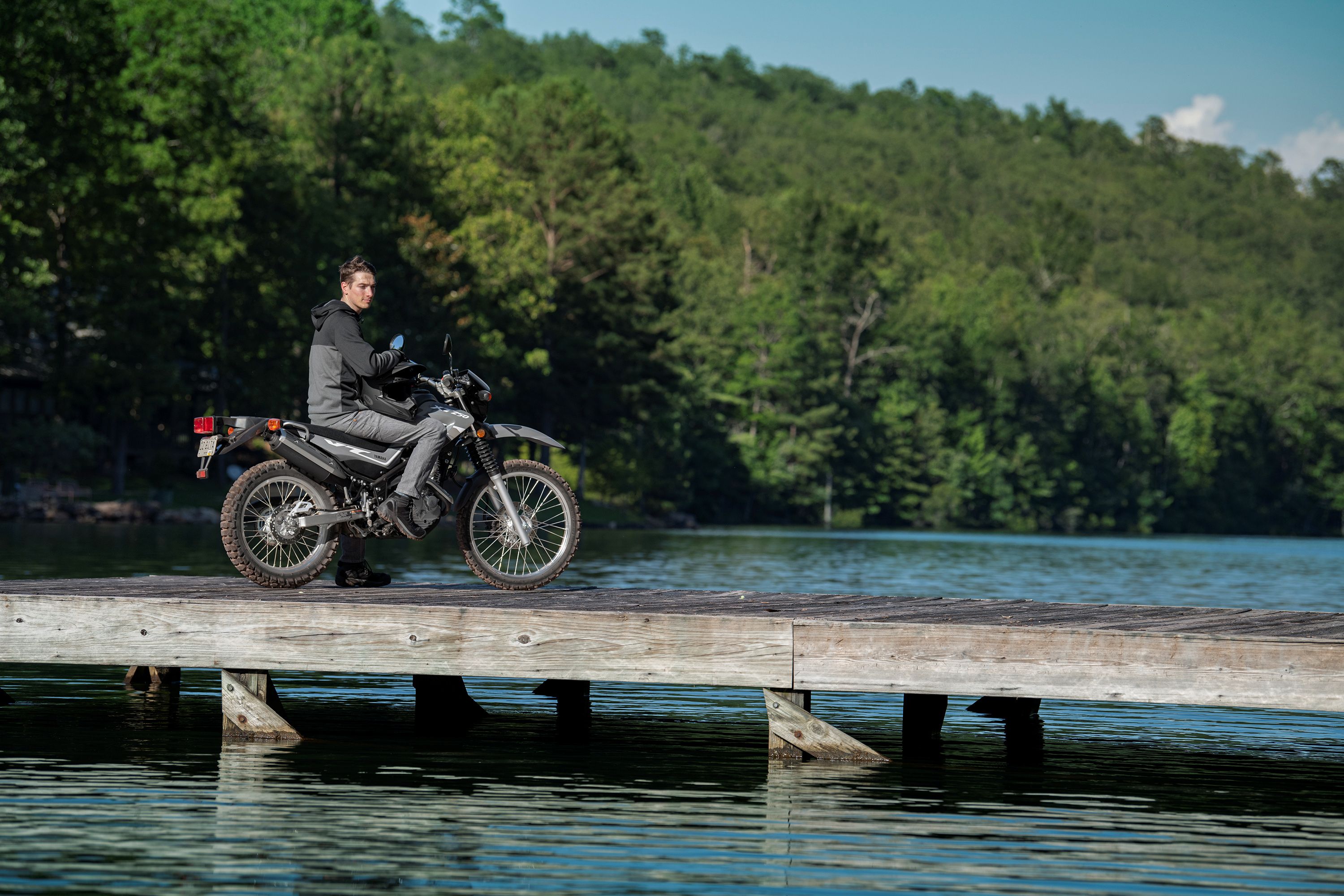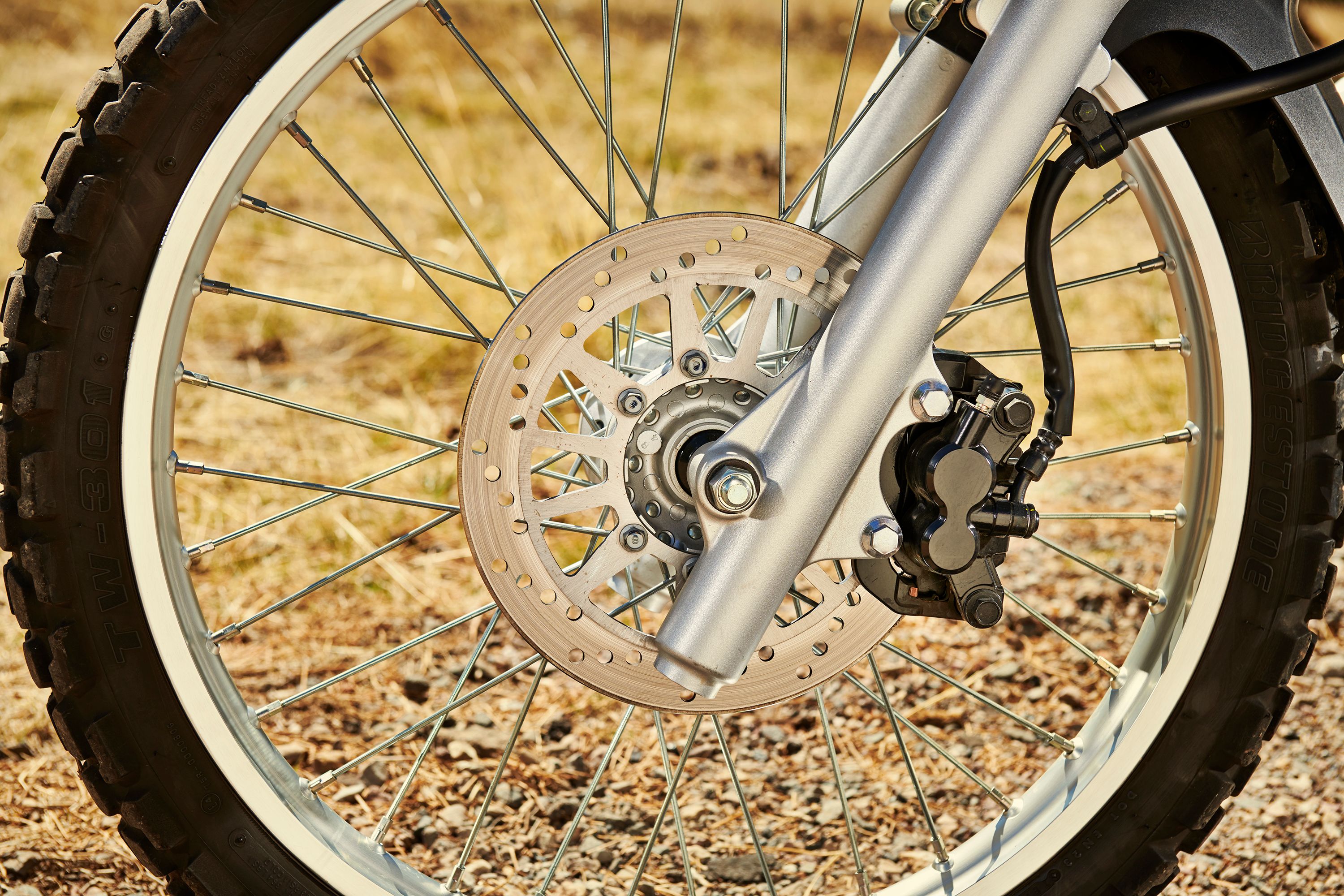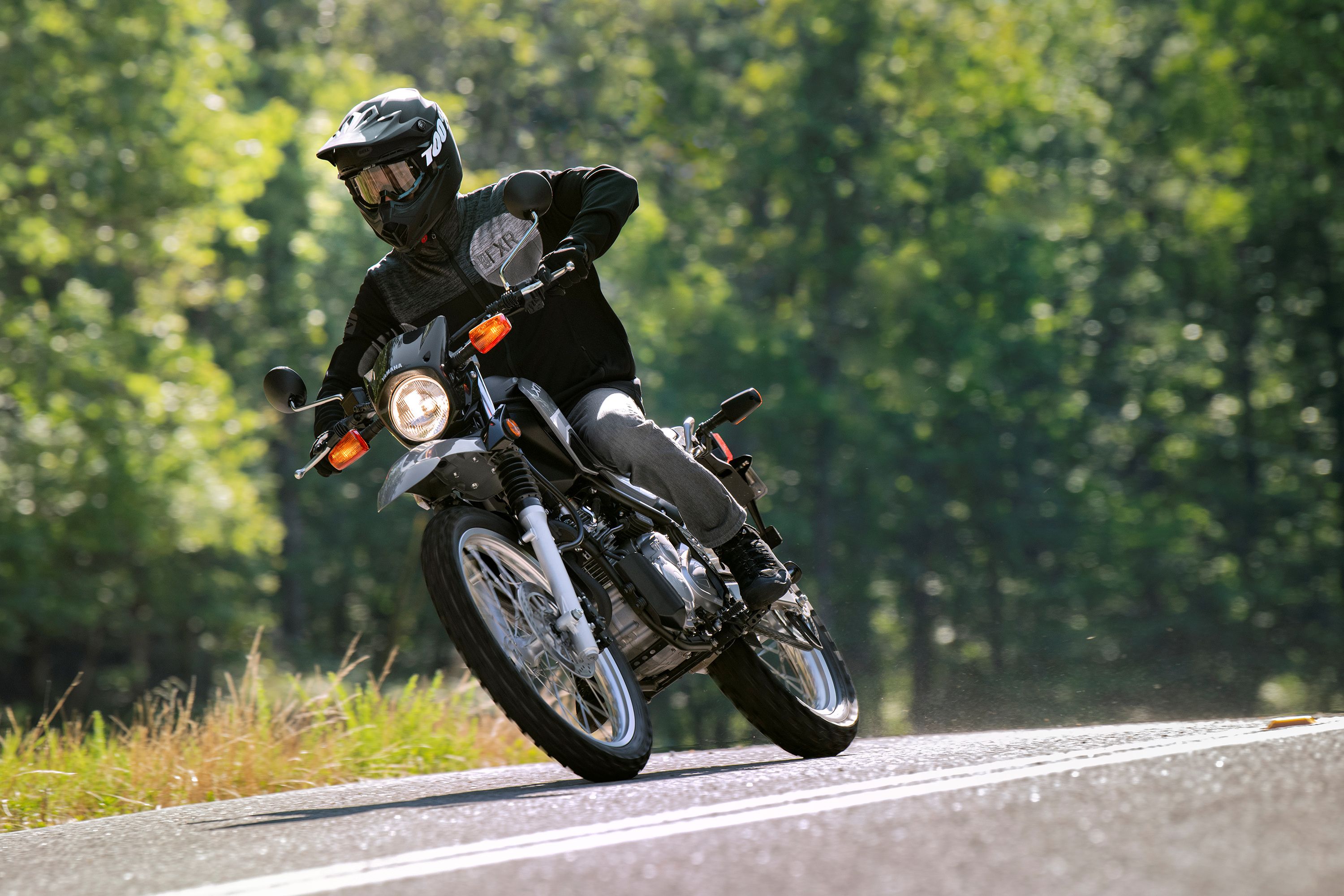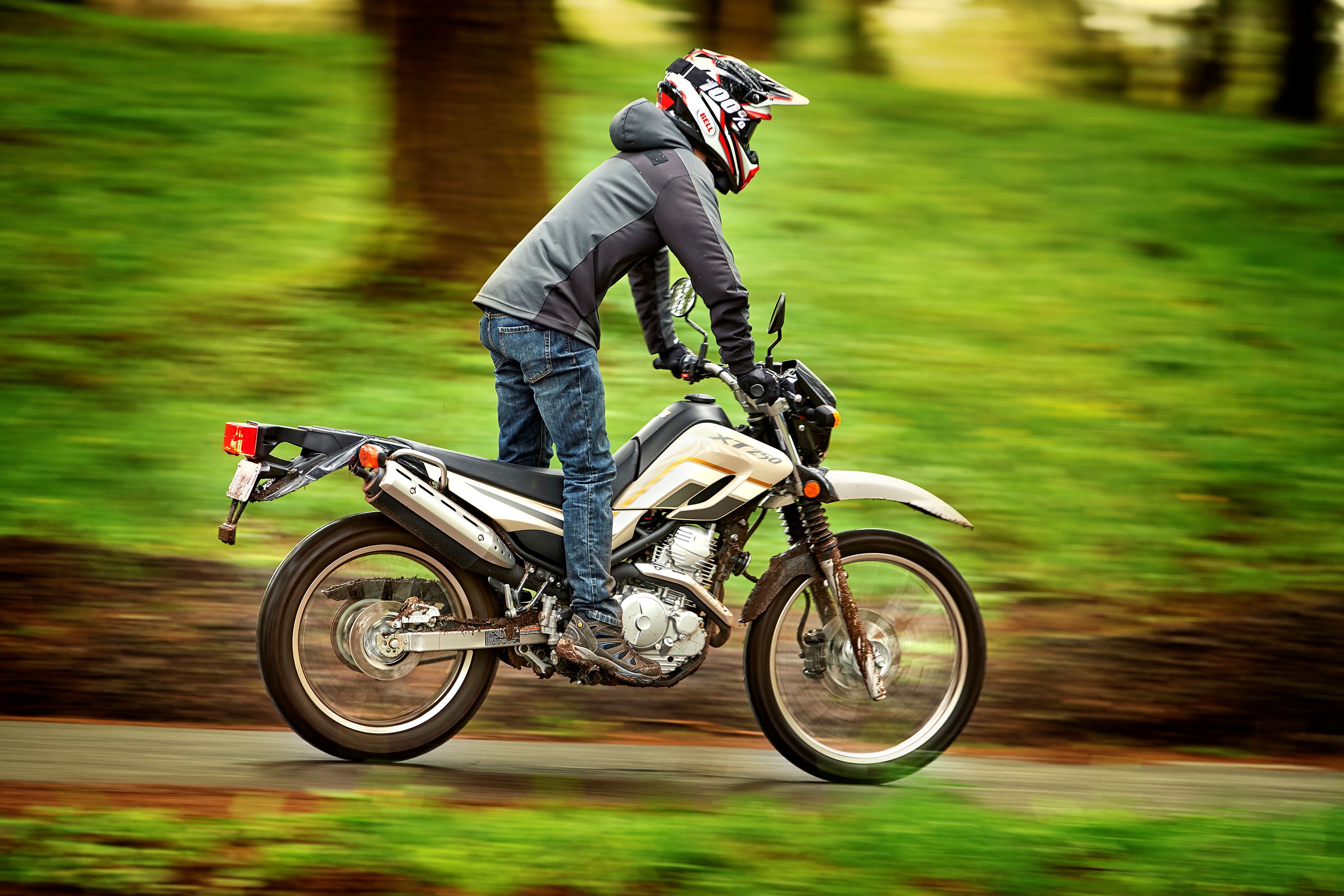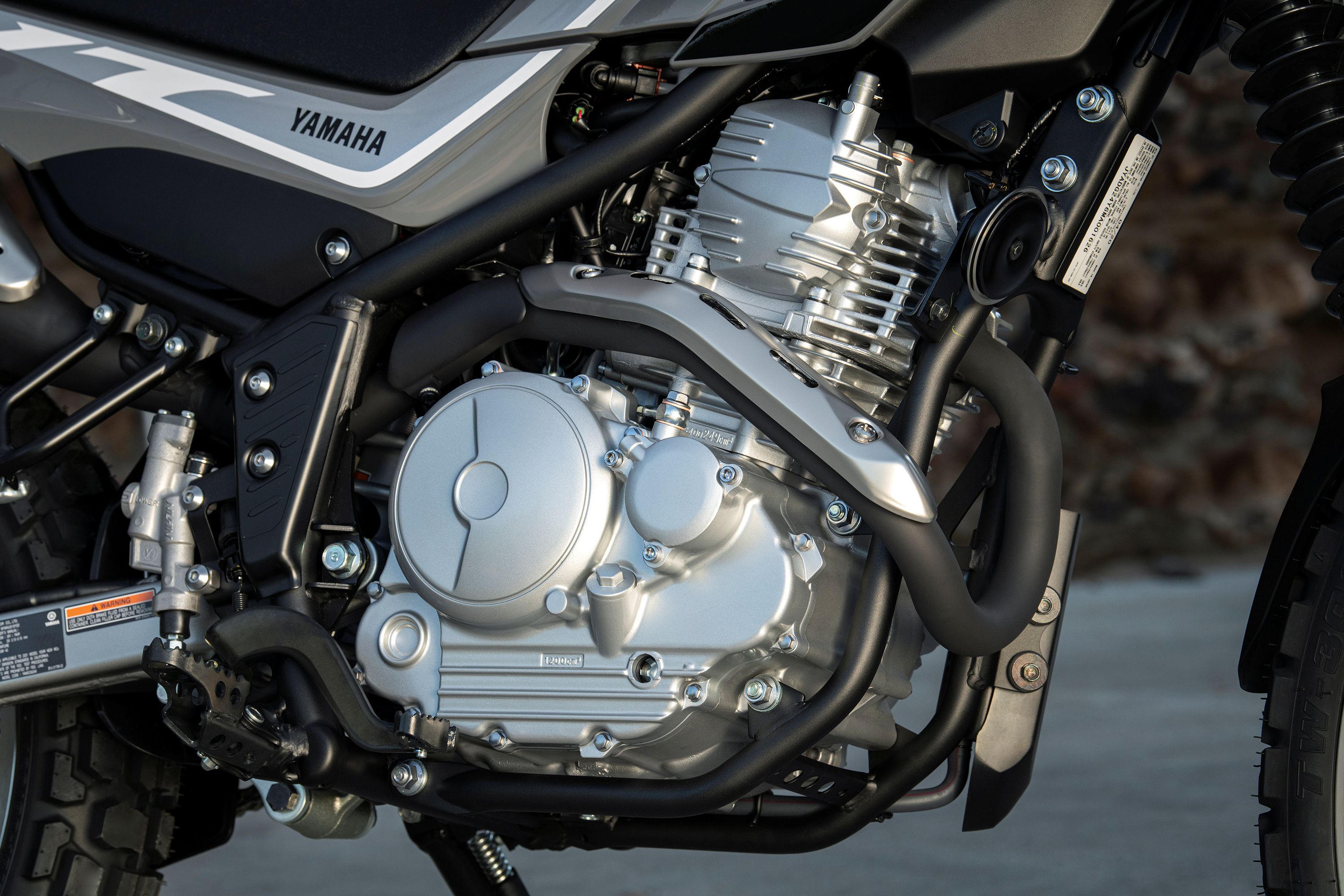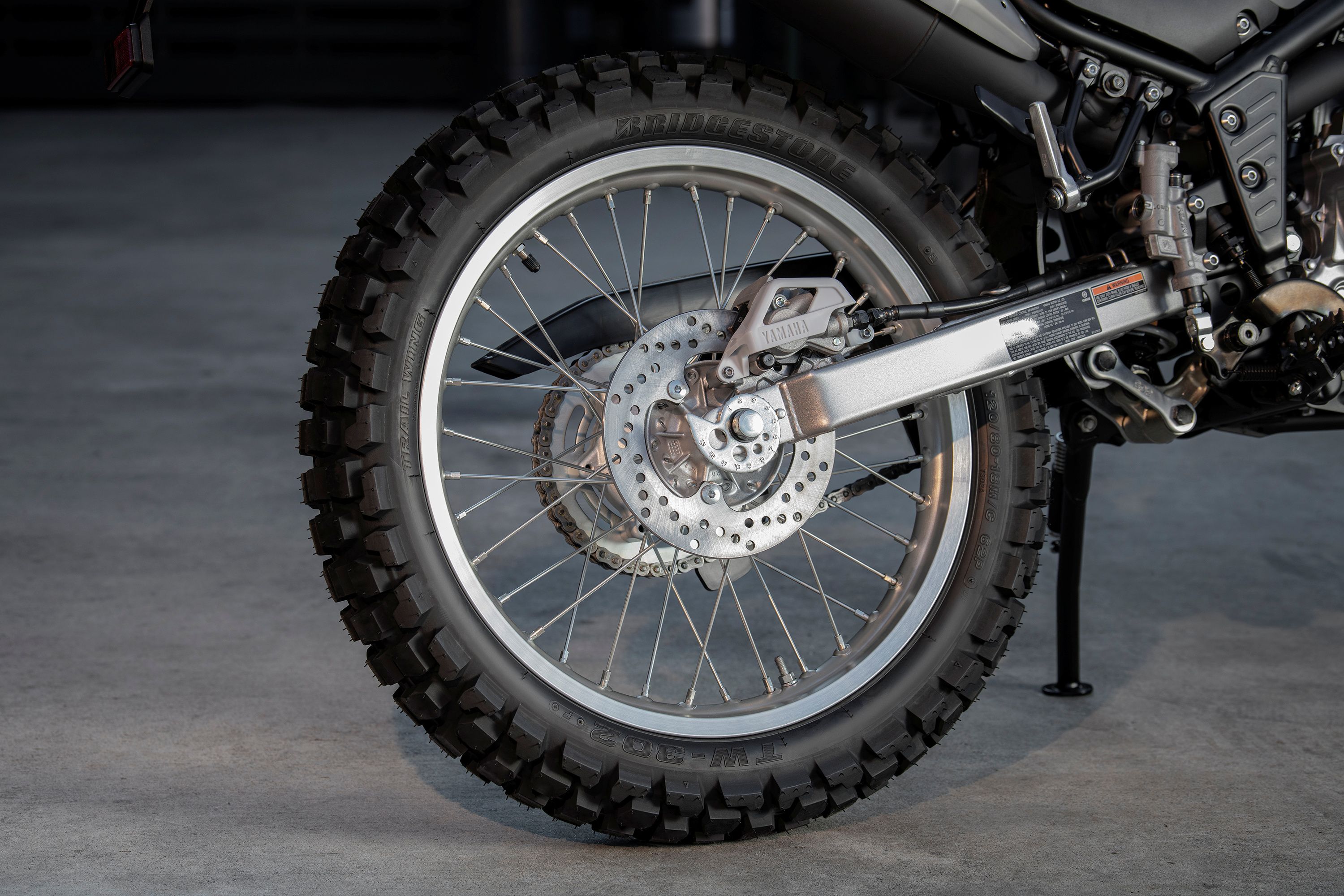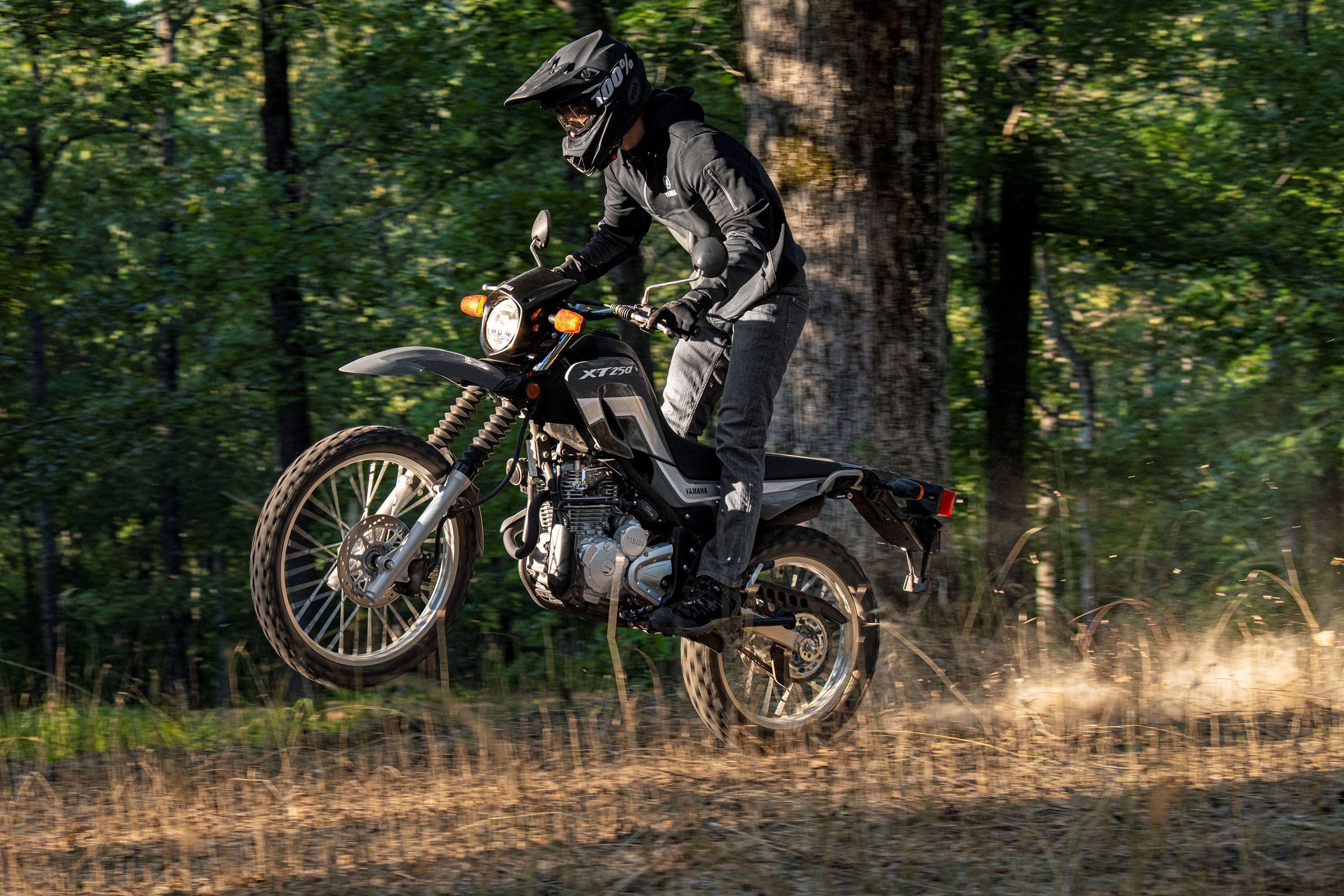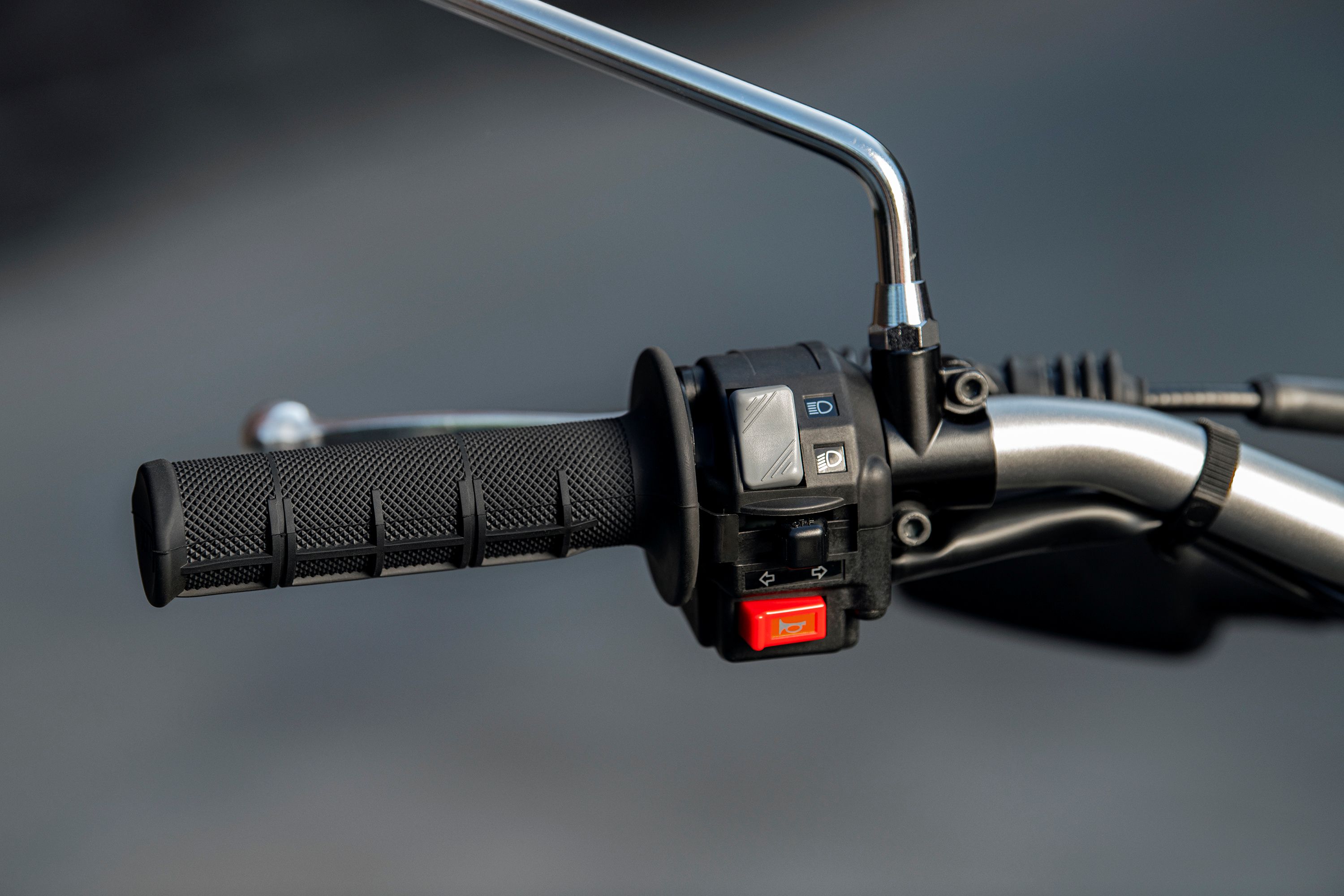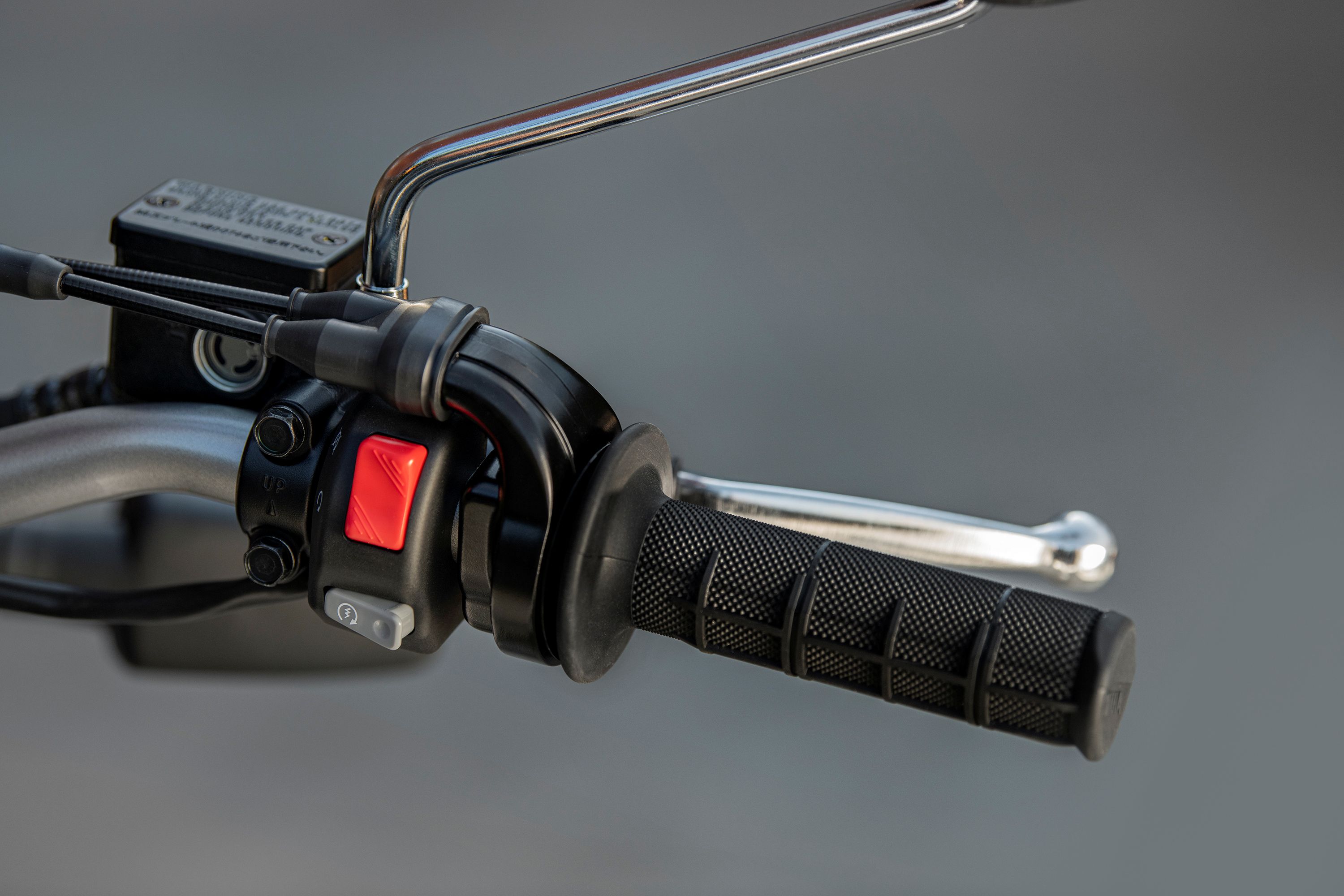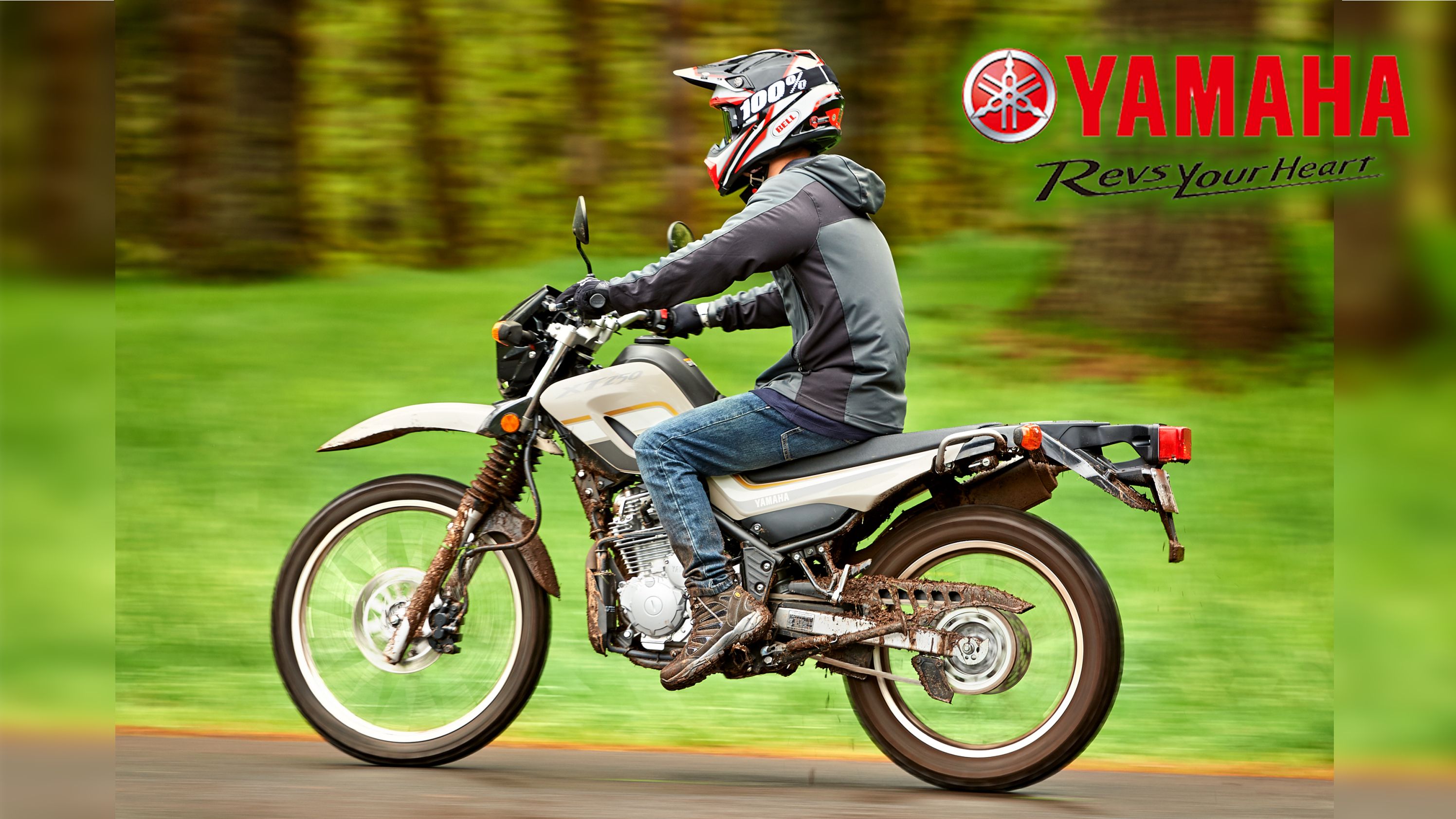With a wide-ratio five-speed and an air-cooled 250 cc engine, the Yamaha XT250 is a proper little dual-sport machine and with a little more attention to two-up riding than you might expect in an off-road-capable bike.
Yamaha XT250 Design
It seems like when God said “Let there be light,” Yamaha was already making the XT250. Okay, maybe not that long ago, but it has been since 1980 and I'll bet a lot of folks reading this weren't born yet. In 1982, Rambo rode one inFirst Blood. If it was mean enough to carry Sylvester Stallone, you know it was pretty awesome.
Two things that I find notable about the XT250 -- each one not so much individually, but together, yes -- are the relatively low seat height and and the more-than-adequate ground clearance. Off-road bikes are usually quite tall, so the seat height of less-than-32 inches is low for an off-road capable bike, yet the ground clearance is a skosh over 11 inches -- still quite respectable. Kudos Yamaha.
The XT250 handles very nicely, even at low speeds and given that the turning angle is 51 degrees -- almost into trials-bike territory -- and has a short wheelbase, it's no surprise that it has a super-tight turning radius and maneuverability worth mentioning. And it's lightweight, only 291 pounds.
The compact LCD instrument panel has green background lighting. It's supposed to make it easier to see, and I suppose it does, but I prefer analog gauges. Those dials are easier for me to read at a glance, but they do add weight to the handlebars that would not be welcome here.
Anything that sticks out is vulnerable when heading off into the woods, so the flex-mounted turn-signals are a check in the plus column. When you take a street-legal bike off the pavement into the woods, you want it to still be street-legal when you come out.
Yamaha wants you to believe the seat is comfortable. I'm not going to endorse that, but it is as two-up friendly as I've seen. The XT250 has frame-mounted passenger footpegs for those times you want to take off with a friend.
As far as the highway goes, you're okay. The XT250 cruises at 60 mph without having to wind it up tighter than Dick's handband, but stay off the interstate. I don't think you want to maintain 70 mph, at least not for any length of time, and you'll have no roll-on at that speed. As a commuter or a bopping-around-town bike, it's awesome. For heading off for some light off-road fun, you've got it made. You'll have to decide if the 2.6-gallon fuel tank is enough for your travels.
Yamaha XT250 Chassis
Off-road riders have long maintained that steel frames provide just the right amount of flex and give that takes the edge off the rudest bumps, and Yamaha took that to heart. The XT250 runs with a steel backbone with a single downtube and bolted on double-cradle to support the engine and complete the assembly.
While Yamaha displays an awareness of the dangers associated with off-road riding by adding fork boots and a wide front fender, I wonder at the lack of a skid plate to protect the engine against terrain strikes. Sure, the double-cradle frame provides some protection, but not as much as a proper plate.
The steering head layout gives us a 26.4-degree rake and 4.2 inches of trail for fairly nimble handling. Add that to what I already mentioned about the turning angle that swings through a full 51 degrees and you have the capability of very tight maneuvers at low speeds.
A set of 35 mm forks support the front end, and a monoshock on a progressive linkage tames the swingarm. True to its nature, suspension travel strikes a balance between street-size strokes and full-blown motocross. The front forks provide 8.9 inches of travel, but no adjustments of any sort, while the rear shock gives up 7.1 inches of travel and comes with adjustable rebound damping plus the usual preload adjuster. This combination gives the XT250 a comfortable ride on poor roads and off-road, but you can't quite treat it like you would a dedicated dirt machine.
The XT250 rolls on laced aluminum rims, with an 18-incher in back and a big, 21-incher up front. Both the size and choice of rim construction is geared toward the brown and the street-flats on the knobby tires help keep it dirty-side down when the brown turns back to black. A dual-pot caliper pinches a 245 mm single disc up front and a single-pot caliper pinches a 203 mm disc in back.
Frame construction, suspension components, and wheel diameter all add up to a compact, 53.5-inch wheelbase and 84.6-inch overall length. Ground clearance is sufficient for rough terrain at 11.2 inches, and the seat stays below the nosebleed section at 31.9 inches off the ground.
|
Suspension / Front: |
35 mm telescopic fork; 8.9-in travel |
|
Suspension / Rear: |
Swingarm w/rebound-adjustable single shock; 7.1-in travel |
|
Rake (Caster Angle): |
26.4° |
|
Trail : |
4.2 in |
|
Brakes / Front: |
245 mm disc |
|
Brakes / Rear: |
203 mm disc |
|
Tire / Front: |
2.75-21 |
|
Tire / Rear: |
120/80-18 |
Yamaha XT250 Drivetrain
Yamaha powers the XT250 with its four-cycle, 249 cc thumper. It keeps the mill light and simple with air cooling instead of complicating things with a water jacket and radiator. A forged piston rides within a bore that comes plated for lowered skirt-to-cylinder friction and increased thermal transfer, and a single, over-head cam actuates the twin valves in the head. Bore and stroke measure out at 74 mm and 58 mm, respectively, for a significantly oversquare configuration.
Yamaha's fuel-injection system feeds the little beast, and a transistor-controlled ignition (TCI) handles the sparkage for a long-legged, 76 mpg. Power figures vary depending on whose dyno was used, but unofficially the XT250 puts out something between 16 and 18 ponies. This is barely enough for highway speeds, but is fine for its designed purpose and makes the XT250 capable in rough terrain and on other-than-interstate roads.
|
Engine: |
Air-cooled, SOHC 4-stroke single; 2 valves |
|
Displacement: |
249 cc |
|
Bore x Stroke: |
74.0 mm x 58.0 mm |
|
Compression Ratio: |
9.5:1 |
|
Fuel Delivery: |
Yamaha Fuel Injection |
|
Ignition: |
TCI: Transistor Controlled Ignition |
|
Transmission: |
5-speed; multiple-disc wet clutch |
|
Final Drive: |
Chain |
Yamaha XT250 Pricing
MSRP on the 2022 XT250 is $5,199, same as it has for several years now. Yamaha covers your XT250 with a one-year limited factory warranty.
|
Warranty: |
1 Year (Limited Factory Warranty) |
|
Color: |
|
|
└ 2015: |
Team Yamaha Blue/White |
|
└ 2016, 2017: |
Mineral Blue |
|
└ 2018 - 2020: |
Sandy Beige |
|
└ 2021, 2022: |
Radical Gray |
|
Price: |
$5,199 |
Yamaha XT250 Competitors
Right off the top of my head, I want to look at the CRF250L from Honda, but it seems more road oriented, being a bigger, heavier bike. Instead, let's go with the DR200S from Suzuki. It's a proper little dual sport with an air-cooled engine.
Suzuki DR200S
Visually the two are very similar. Both carry the front fender on the tripletree to keep unsprung weight low at the front wheel, and follow the typical dual-sport design with the Suzuki showing more in the way of dirt bike undertones. The upper lines tumble from the headlight housing down the sharp rise in the fuel tank to the gentle swale of the bench seat that leaves plenty of room for weight shifts on both models.
Suspension is roughly equivalent, as well. Neither offer any adjustment to the front forks, and the Suzuki rear shock only allows for preload changes, but no damping adjustment. The Suzuki suspension provides 8.1 inches of travel all around versus 8.9-inches front and 7.1-inches rear travel with the Yamaha. Lack of all-around disc brakes was something of a surprise on the Suzuki with its mechanical drum rear binder -- not exactly a selling point, guys.
Both motors run with air-cooling and a SOHC arrangement, but the Suzuki is a bit smaller than the 249 cc Yamaha at only 199 cc. Suzuki kept things simpler with a carburetor instead of using fuel injection to manage induction, and I do not count that as a strike against it, in fact I consider the carb to be a bonus. To be fair, this is mainly because I know how to work on carbs and I don't need fancy tech tools, but I realize not everyone enjoys such knowledge and will prefer an injected motor with the expensive diagnostic tools that go with it. To each his or her own.
Suzuki picks up a small victory at the till with a much smaller sticker price, no surprise. At $4,649, the DR200S leaves a lot of money on the table for gear and accessories compared to the $5,199 starting price on the XT250. Of course, you get a bit more motor on the XT for that price, but depending on how you plan to use it, the 199 cc plant in the DR might just be enough.
Read our full review of the Suzuki DR200S.
He Said
My husband and fellow motorcycle writer, TJ Hinton, says, “Another little dual-sport, and another little bike that does two different things, and neither as well as a purpose-built bike in a traditional genre. While I suppose, theoretically, it keeps you from having to buy two separate bikes, I suspect the main benefit is that you can ride your dirt bike down the street to your favorite trail or whatever, and save having to buy a trailer and a truck with which to haul it around. Honestly, at this size, dual-sports are kind of pointless unless you're using one as a trainer for a big dual-sport or a proper adventure bike.”
She Said
“I disagree with my husband on this one. I think these little 250 cc dual sport bikes have their place. Some folks don't want or need a bigger engine and aren't looking to upgrade to a big adventure bike. They're inexpensive, spunky little bikes and so much fun to tear up the field. Who wouldn't want one in the garage?”
Yamaha XT250 Specifications
|
Engine & Drivetrain: |
|
|
Engine: |
Air-cooled, SOHC 4-stroke single; 2 valves |
|
Displacement: |
249 cc |
|
Bore x Stroke: |
74.0 mm x 58.0 mm |
|
Compression Ratio: |
9.5:1 |
|
Fuel Delivery: |
Yamaha Fuel Injection |
|
Ignition: |
TCI: Transistor Controlled Ignition |
|
Transmission: |
5-speed; multiple-disc wet clutch |
|
Final Drive: |
Chain |
|
Chassis: |
|
|
Suspension / Front: |
35 mm telescopic fork; 8.9-in travel |
|
Suspension / Rear: |
Swingarm w/rebound-adjustable single shock; 7.1-in travel |
|
Rake (Caster Angle): |
26.4° |
|
Trail : |
4.2 in |
|
Brakes / Front: |
245 mm disc |
|
Brakes / Rear: |
203 mm disc |
|
Tire / Front: |
2.75-21 |
|
Tire / Rear: |
120/80-18 |
|
Dimensions & Capacities: |
|
|
L x W x H: |
84.6 x 31.7 x 45.7 in |
|
Seat Height: |
31.9 in |
|
Wheelbase: |
53.5 in |
|
Ground Clearance: |
11.2 in |
|
Fuel Capacity: |
2.6 gal / California model 2.4 gal |
|
Fuel Economy: |
76 mpg |
|
Wet Weight: |
291 lb |
|
Top Speed: |
75 mph (est) |
|
Details: |
|
|
Warranty: |
1 Year (Limited Factory Warranty) |
|
Color: |
|
|
└ 2015: |
Team Yamaha Blue/White |
|
└ 2016, 2017: |
Mineral Blue |
|
└ 2018 - 2020: |
Sandy Beige |
|
└ 2021, 2022: |
Radical Gray |
|
Price: |
$5,199 |
Further Reading
Yamaha
|
|
link=mot301> |
Read more Yamaha news.


